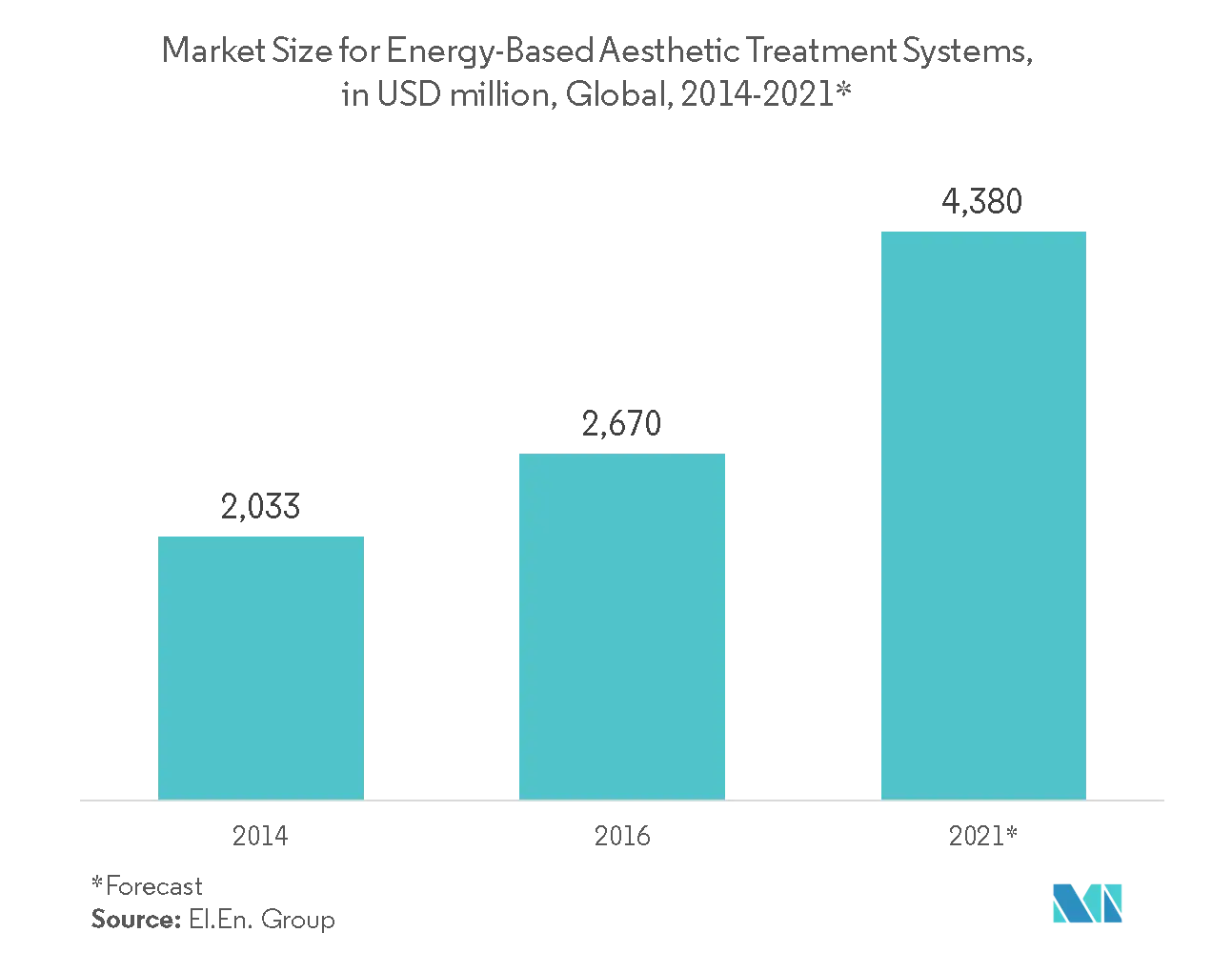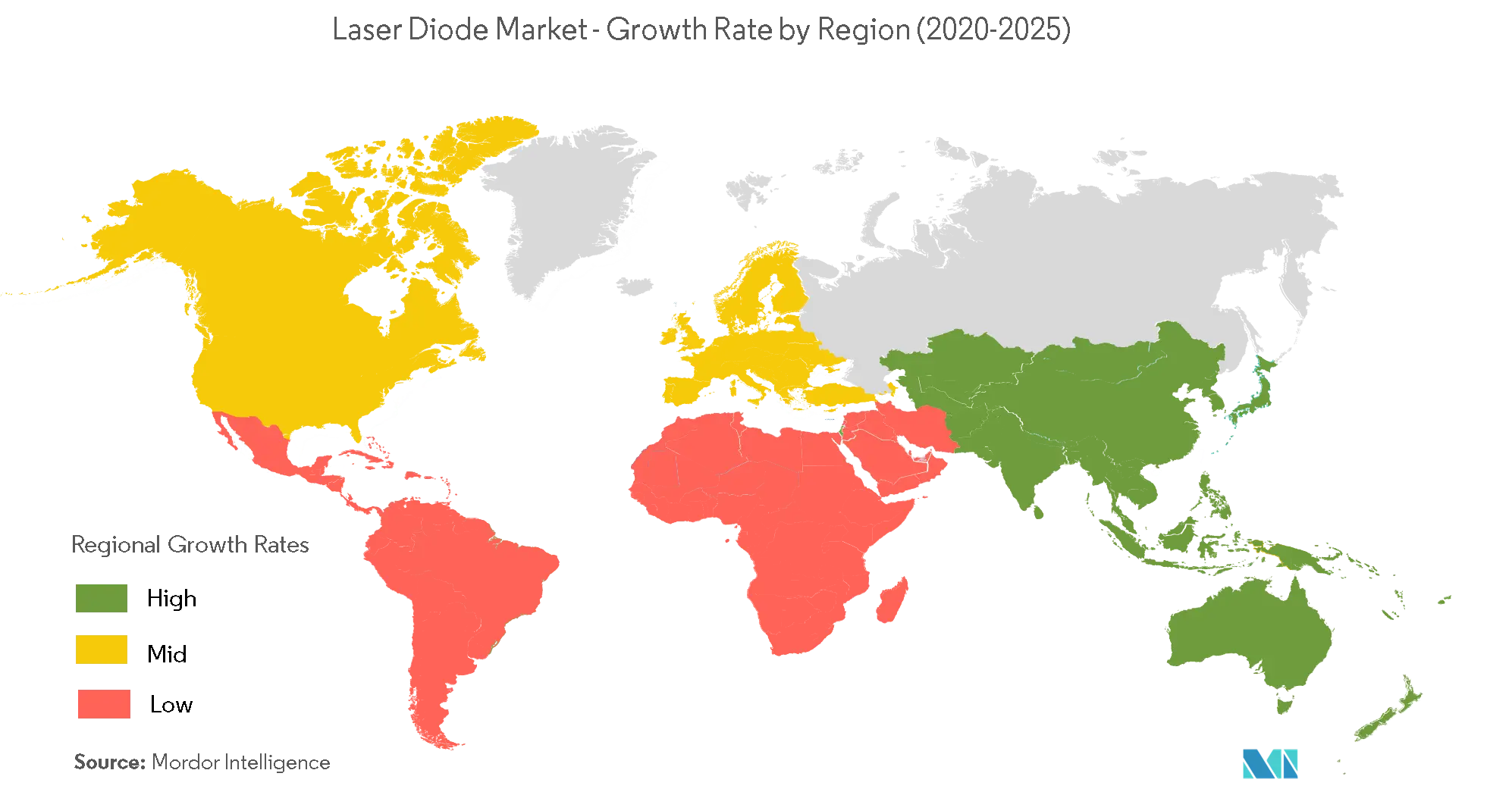Market Trends of Laser Diode Industry
This section covers the major market trends shaping the Laser Diode Market according to our research experts:
Adoption of Laser in Medical and Healthcare to Drive the Market Growth
- The past few years have witnessed increased demand for laser diodes in the healthcare sector owing to their assistance to physicians to focus the beam with better precision on directed areas, preventing unwanted damage to the surrounding area.
- However, these lasers are used to process plastics for medical devices (polymer processing). There is an increased demand for cosmetic surgery procedures, which include surgical and non-surgical procedures that improve the appearance by reshaping and enhancing the body structure. For instance, according to American Society of Plastic Surgeons (ASPS), almost 18 million people underwent surgical and minimally invasive cosmetic procedures in the United States in 2018 for contouring, skin resurfacing, wrinkle and pigmentation reduction, and tattoo removal, providing the growth to the energy-based aesthetic treatment system.
- Of all the wavelengths in which the laser diode operates, the green laser diodes have operational advantages over other wavelengths. As these green laser diodes are capable of operating in a wide range of temperatures, have a long lifetime, and are highly reliable at continuous operation, the growth potential of this type of laser diodes is high.
- The applications of green laser diodes include projection applications, biotechnology, spectroscopy, medical applications, etc. Due to the increased demand in the healthcare sector, green laser diodes are expected to occupy the largest share of the laser diode market during the forecast period.
- Besides, lasers available in the femtosecond and picosecond variants, are slowly gaining traction in the medical equipment. Femtosecond variant lasers are widely used for marking the glass, allowing the traceability of syringes and other glass devices. Also, laws mandating the marking of medical devices across various regions are further driving the increasing demand for ultrafast lasers, whose applications included stents and catheters.
- Further, these lasers are being used for processing plastics for medical devices, also known as polymer processing. There is an increased demand for cosmetic surgery procedures, which include surgical and non-surgical procedures that improve the appearance by reshaping and enhancing the body structure. For instance, according to the American Society of Plastic Surgeons (ASPS), the total number of minimally-invasive cosmetic treatments has gone up a whopping 228% since 2000.
- However, these lasers are used for processing plastics for medical devices (polymer processing). There is an increased demand for cosmetic surgery procedures, which include surgical and non-surgical procedures that improve the appearance by reshaping and enhancing the body structure. For instance, according to the American Society of Plastic Surgeons (ASPS), almost 18 million people underwent surgical and minimally invasive cosmetic procedures in the United States in 2018.

Asia-Pacific to Witness a Significant Growth
- The laser diode market in the Asia-Pacific region is witnessing robust growth, primarily owing to the widespread presence of electronics and automobile manufacturing organizations and an increase in the purchasing power of consumers. The region is also witnessing a growth in the adoption of smartphones and digitization of business processes, fuelling the adoption of laser diodes to cater to the booming consumer electronics and automotive sector.
- The growing demand for smartphones and other major consumer electronics products from countries, such as China, the Republic of Korea, India, and Singapore, are encouraging many companies to set up production establishments in the Asia-Pacific region. The abundant availability of raw materials and the low establishment and labor costs are also helping the companies launch their production centers in the region.
- For instance, in October 2019, an Australian semiconductor developer, BluGlass Ltd, announced its direct-to-market business unit, which will offer higher brightness and higher efficiency GaN laser diodes. The laser diodes can be used in various commercial applications, such as industrial lasers, automotive and general lighting, displays, and life sciences.
- The Asia-Pacific semiconductors market was boosted by the strong domestic demand, causing the market to become the largest in the world. According to WSTS, in 2019, the semiconductor industry in the Asia-Pacific region (except Japan) was expected to reach revenues of around USD 297 billion.
- Further, in May 2019, researchers from Japan demonstrated that a long-elusive kind of laser diode based on organic semiconductors is possible, making way for the further expansion of lasers in applications, such as displays, biosensing, healthcare, and optical communications. The organic laser diodes use carbon-based organic materials, primarily to emit light instead of the inorganic semiconductors, such as gallium arsenide and gallium nitride, which were used in traditional devices.
- Additionally, in January 2020, USHIO announced the launch of a new 660nm red laser diode, which produces an output power of 200mW CW/400mW pulsed. The series is available with three different types of connectors—CC, AC, or FN—designated as HL65221DG, HL65222DG, and HL65223DG, respectively. These high-power laser diodes offer a built-in monitoring photo-diode at the lasing wavelength.


